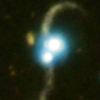CXC Home | Search | Help | Image Use Policy | Latest Images | Privacy | Accessibility | Glossary | Q&A
Tour of SDSS J1254+0846
Quicktime MPEG
Two quasars have been caught in the act of merging, thanks to this new image. Quasars are some of the brightest objects in the universe and are thought to be very distant galaxies with powerful black holes at their centers. This particular pair is located about 4.6 billion light years from Earth. In this image, X-rays from Chandra show the two quasars as bright blue circles. Optical data from a telescope in Chile show tidal tails fanning out from the two colliding galaxies. These tails contain streams of stars and gas that have been stripped by gravity as the two galaxies head towards their ultimate collision.
[Runtime: 00:45]
Quicktime MPEG
Two quasars have been caught in the act of merging, thanks to this new image. Quasars are some of the brightest objects in the universe and are thought to be very distant galaxies with powerful black holes at their centers. This particular pair is located about 4.6 billion light years from Earth. In this image, X-rays from Chandra show the two quasars as bright blue circles. Optical data from a telescope in Chile show tidal tails fanning out from the two colliding galaxies. These tails contain streams of stars and gas that have been stripped by gravity as the two galaxies head towards their ultimate collision.
[Runtime: 00:45]
(Credit: X-ray (NASA/CXC/SAO/P. Green et al.), Optical (Carnegie Obs./Magellan/W.Baade Telescope/J.S.Mulchaey et al.)
Return to SDSS J1254+0846 (February 3, 2010)



